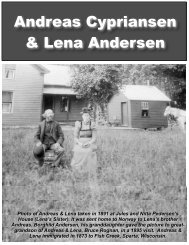Viking Heraldy of Lewis & Cinda - Bruce Rognan
Viking Heraldy of Lewis & Cinda - Bruce Rognan
Viking Heraldy of Lewis & Cinda - Bruce Rognan
Create successful ePaper yourself
Turn your PDF publications into a flip-book with our unique Google optimized e-Paper software.
Harald Sigurdson Hardrade (1015-1066)<br />
Harald the Ruthless was born in 1015 in Ringerike (Buskerud). His first marriage was to Yelisaveta Yaroslavsdatter<br />
<strong>of</strong> Kiev circa 1045. Secondly, he was married to Tora Torbergsdatter <strong>of</strong> Giske in 1047. His harsh suppression<br />
<strong>of</strong> lesser Norwegian chieftains cost him their military support in his unsuccessful struggle to conquer Denmark<br />
(1045-62). The son <strong>of</strong> Sigurd Syr, a chieftain in eastern Norway, and <strong>of</strong> Estrid, Harald fought at the age <strong>of</strong><br />
15 against the Danes with Olaf II in the celebrated Battle <strong>of</strong> Stiklestad (1030) in which Olaf was killed. He then<br />
fled to Russia, where he served under the grand prince <strong>of</strong> Kiev, Yaroslav I the Wise, whose daughter Elizabeth<br />
he later married. After enlisting in the military service <strong>of</strong> the Byzantine emperor Michael IV (reigned 1034-41),<br />
he fought with the imperial armies in Sicily and Bulgaria and made a pilgrimage to Jerusalem.<br />
Upon his arrival in Southeastern Norway, Harald, the wealthiest <strong>Viking</strong>, gave half <strong>of</strong> his wealth to Magnus the<br />
Good. They both entered into a joint alliance as co-kings. Magnus was murdered by Harald the Ruthless, 2<br />
years later and Harald Sigurdsson (the Ruthless) then led Norway to significant military battles in the future.<br />
He spent the next 15 years attempting to wrest the Danish throne from Svein II. After Svein’s defeat in the Battle<br />
<strong>of</strong> Niz (1062), the two rulers recognized each other as sovereign in their respective countries. Harald also<br />
quarreled with Pope Alexander II and Adalbert, the archbishop <strong>of</strong> Bremen and the Holy Roman emperor's vicar<br />
for the Scandinavian countries. Harald antagonized the two prelates by maintaining the independence <strong>of</strong> the<br />
Norwegian church.<br />
Harald expanded Norway's colonial possessions in the<br />
Orkney, Shetland, and Hebrides islands and in 1066 attempted<br />
to conquer England, allying himself with the<br />
English rebel earl Tostig against the new English king,<br />
Harold II. After gaining initial victories, Harald's forces<br />
were routed by the English king in September 1066 at<br />
Stamford Bridge, where Harald was killed. His son Magnus<br />
(c. 1048-69) succeeded him and ruled jointly with<br />
Olaf III, another <strong>of</strong> Harald's sons, until Magnus' death in<br />
1069.<br />
Nineteen days after his death the battle <strong>of</strong> Hasting was<br />
fought and William the Conqueror gained the throne <strong>of</strong><br />
England. Duke William was a descendant <strong>of</strong> the <strong>Viking</strong><br />
Rollo Rognalvaldsen (a nephew <strong>of</strong> King Harld the Fairhaired.<br />
Rognavald, a might sea-king and pirate, who<br />
had been banished from Norway by King Harald Haarfagre, because<br />
he had raided on <strong>of</strong> his provinces. settled in Rouen, Normandy with his followers; there he received a<br />
land grant from Roger de Hauteville, Duke <strong>of</strong> France, and later married his daughter. This century was a trying<br />
time for the British, their shores were continually raided by sea pirates and ambitious kings from Scandinavia.<br />
It is interesting to note, that all <strong>of</strong> the fighting in Europe at this time was between family members. William the<br />
Conqueror was a descendant <strong>of</strong> Harald. Harald Sigurdsson was also closely related with the Normans, and<br />
Russians. The Norsemen (Normans) in France have now become more French than Norwegian, adopting their<br />
cultures and traditions. Likewise the Rus in Russia, and Anglos and Saxons in England are have lost most <strong>of</strong><br />
their Norwegian/<strong>Viking</strong> influence. The <strong>Viking</strong>s in Sicily have also diluted their customs and culture. The Wars in<br />
Europe are now fought by various forms <strong>of</strong> <strong>Viking</strong>s, in the name <strong>of</strong> Christianity. The rising world threat from the<br />
Moslem world, leads all <strong>of</strong> these <strong>Viking</strong>s to unite again in 1095 for the crusades - the ultimate <strong>Viking</strong> Battles.<br />
The <strong>Viking</strong> age came to an end in 1066. After this year there were never any more raids or plundering initiated<br />
by the Scandinavian <strong>Viking</strong>s. Because they have become so integrated with other Europeans, they are no<br />
longer called <strong>Viking</strong>s. Once the religion <strong>of</strong> the Norse Mythologies had been replaced by Christianity, the <strong>Viking</strong>s<br />
no longer had a purpose or a cause. Their culture died, and they merged with the rest <strong>of</strong> Chrsitendom.<br />
Olaf Kyrre Haraldson (1050-1093)<br />
THE KINGDOM OF NORWAY



